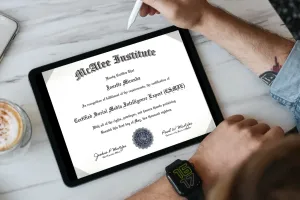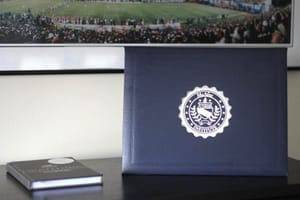Why Basic Bloodstain Pattern Analysis Training Is Essential for Modern Investigations
A basic bloodstain pattern analysis course often finishes with a simple attendance certificate. McAfee Institute delivers far more: our board-certified credentials carry national recognition and outclass the generic certificates most competitors issue. Students also receive lifetime access to materials, free updates when standards change, and live instructor support—benefits rarely found in other 40-hour programs.
Because blood obeys strict physical laws, well-trained analysts can turn stains into a factual narrative that withstands courtroom scrutiny. Our curriculum marries scientific theory with rigorous practical work so graduates can testify with confidence.
Key Facts at a Glance
- Duration: 40 hours (5 days)
- Format: ≈ 50 % hands-on lab / 50 % classroom
- Credits: IABPA & IAI approved (40 CE hours)
- Class Size: ≤ 20 students
- Cost: $595 – $799
- Prerequisite: basic crime-scene experience recommended
- Ideal For: investigators, lab analysts, prosecutors

What Is Bloodstain Pattern Analysis & Why It Matters
Imagine entering a crime scene where the blood speaks more reliably than any eyewitness. Bloodstain pattern analysis (BPA) is the science that lets investigators translate those stains into a clear reconstruction of violent events. By fusing physics, biology, and trigonometry, trained analysts extract measurable facts from what first appears to be chaos.
Blood behaves predictably. When a firearm discharges near a bleeding victim, two distinct patterns emerge: forward spatter travels toward the victim, while backspatter moves toward the shooter. Recognizing such differences helps pinpoint shooter position, weapon type, and sequence of actions.
BPA’s greatest strength is its exclusionary power. Objective patterns can confirm or refute statements, expose false alibis, and solidify testimony in court—often making the difference between conviction and acquittal.
The Science Behind the Stains
Blood is a non-Newtonian fluid; its viscosity changes under stress. Surface tension keeps a droplet spherical until it strikes a surface. The resulting stain’s length-to-width ratio reveals its angle of impact, while droplet size categorizes velocity—from gravity-driven drips to the fine mist of gunshot spatter.
Key Investigative Questions Answered by BPA
- Where did the blood originate? Convergence and origin calculations reveal 3-D positions of victims and assailants.
- What weapon was used? Bats, knives, and firearms each leave signature patterns.
- How were people positioned and moving? Cast-off arcs and voids map movements during the assault.
- Does the evidence match witness accounts? Scientific patterns validate truth or expose deception.
Inside a Basic Bloodstain Pattern Analysis Course
When you're ready to dive into bloodstain pattern analysis, understanding what makes a quality course is essential. The 40-hour duration has become the gold standard for basic bloodstain pattern analysis courses, and there's good reason for this benchmark.
The International Association of Bloodstain Pattern Analysts (IABPA) established these guidelines to ensure students get comprehensive coverage of essential topics while having enough time for proper hands-on training. You simply can't learn bloodstain analysis from a textbook - you need to see how blood behaves under different conditions and practice measuring real stains.
What sets quality courses apart is their commitment to practical application. The best programs dedicate over 50% of class time to laboratory experiments and mock crime scene exercises. This isn't just busywork - it's the difference between understanding theory and actually being able to analyze evidence in the field.
Class sizes matter tremendously in BPA training. Most reputable courses limit enrollment to 20 students maximum to ensure quality instruction. With smaller groups, instructors can provide individual guidance during practical exercises and make sure every student gets proper supervision during laboratory work.
The investment for quality training typically ranges from $595 to $799 per student, depending on the provider and location. While this represents a significant cost, you're getting 40 hours of credit approved by both the International Association for Identification (IAI) and the IABPA - valuable continuing education credits that advance your forensic career.

Learning Objectives & Outcomes
By the time you complete a basic bloodstain pattern analysis course, you'll have developed a completely new way of reading crime scenes. The most fundamental skill you'll master is pattern recognition - learning to distinguish between passive stains formed by gravity, transfer stains created by contact, and projected stains resulting from force application.
Mathematical precision becomes second nature as you learn to measure bloodstains accurately and apply trigonometry to determine angles of impact. The tangent method and geometric calculations transform from abstract concepts into practical tools for establishing areas of convergence where multiple impact patterns intersect.
Documentation skills receive heavy emphasis throughout the course because proper crime scene recording determines whether your analysis will be admissible in court. You'll practice overall, mid-range, and close-up photography techniques, learning to scale stains properly and maintain chain of custody for evidence collection.
Target Audience & Prerequisites
Basic bloodstain pattern analysis courses welcome a diverse group of law enforcement and forensic professionals who encounter blood evidence in their daily work. Crime scene investigators form the largest segment of attendees, and for good reason - they're the ones who first encounter bloodstain evidence and need to recognize patterns that might otherwise be overlooked.
Detectives find tremendous value in BPA training because it gives them scientific tools to corroborate or challenge witness statements. Understanding bloodstain patterns helps focus investigations and eliminate impossible scenarios, saving countless hours of misdirected effort.
Laboratory analysts who examine bloodstained clothing and weapons need BPA knowledge to interpret the significance of stain patterns and provide meaningful conclusions in their reports. Without this training, they might miss crucial evidence or misinterpret what they're seeing.
While most courses recommend basic crime scene processing experience, no formal degree requirements exist. Some programs welcome university students studying forensic science or criminal justice, and legal professionals may attend to better understand the scientific principles underlying BPA testimony.
Course Format & Structure
The standard five-day schedule allows for comprehensive coverage of both theoretical foundations and practical applications without overwhelming students. Most courses run from 8:00 AM to 5:00 PM daily, with structured breaks and lunch periods to maintain engagement throughout this intensive training.
Day one establishes the foundation with bloodstain pattern analysis history, basic blood composition and behavior, and updated OSAC terminology. You'll learn essential health precautions and personal protective equipment protocols before diving into falling height relationships and non-spatter stain pattern recognition.
Day two explores the taxonomy of bloodstain patterns, teaching you to recognize altered stains and complex multiple-pattern scenarios. Measurement techniques are introduced, along with gamma angle determination and methods for establishing areas of convergence.
Day three focuses on the mathematical aspects of pattern analysis, including trigonometric calculations for determining areas of origin. Photography techniques receive special attention, covering overall scene documentation, mid-range pattern photography, and close-up stain imaging with proper scaling.
Hands-On Training: Equipment, Exercises, Assessment

The real learning happens when you get your hands dirty. The laboratory component of a basic bloodstain pattern analysis course gives you irreplaceable experience that no textbook can provide. You'll work with actual bovine blood under controlled conditions, watching how different forces and angles create completely different spatter patterns.
Think of it like learning to drive - you can study the manual all you want, but you won't really understand until you're behind the wheel. The same principle applies to bloodstain analysis. When you see how a single drop behaves differently at various heights and angles, the science suddenly clicks into place.
Gunshot spatter experiments take place in controlled range environments where you can safely observe high-velocity impact patterns forming. These exercises show you the dramatic difference between entrance and exit wound spatter while highlighting all the variables that can affect what you see at a real crime scene.
Mock crime scene scenarios put everything together in realistic settings. Picture this: you walk into a simulated living room assault scene and must identify multiple pattern types, figure out weapon trajectories, and piece together what happened based solely on the bloodstain evidence. It's like being a detective and a scientist rolled into one.
Digital photography drills ensure you can properly document your findings using the right scaling, lighting, and camera angles. These technical skills are absolutely essential - even the most brilliant analysis means nothing if you can't create court-admissible evidence that accurately shows what you found.
Lab & Field Exercises
Drop angle experiments form the foundation of everything you'll learn. You'll create blood drops from various heights and angles, then measure the resulting stains to verify those theoretical calculations you learned in class. These controlled experiments prove how stain elongation actually correlates with impact angle and help build your confidence in real-world measurements.
Cast-off experiments simulate the patterns created when weapons swing through blood-soaked hair or clothing. You'll observe how different swing speeds and weapon types create distinct linear patterns that reveal information about the number of blows delivered and the weapon's trajectory. It's fascinating to see how much story the blood can tell.
Void analysis exercises teach you to spot and interpret shadow patterns created when objects or people block spatter from reaching surfaces. These "negative" patterns can reveal where individuals were positioned during blood-shedding events. Sometimes what's missing tells you more than what's there.
The final group practical brings everything together in a comprehensive challenge where teams analyze complex scenarios involving multiple pattern types. You'll work collaboratively to document evidence, perform calculations, and develop reconstruction theories that account for every piece of bloodstain evidence you observe.
Gear Checklist for Success
Having the right equipment makes all the difference between amateur snapshots and professional forensic documentation. You'll need a DSLR camera capable of macro photography - smartphone cameras simply don't have the resolution and control necessary for forensic work.
A macro lens captures the detailed close-ups of individual stains that reveal the fine details necessary for accurate measurement and pattern recognition. Pair this with a sturdy tripod to ensure sharp images and consistent framing, especially important for scaled photography that might be scrutinized in court.
Personal protective equipment keeps you safe during both indoor laboratory work and outdoor exercises. PPE includes disposable coveralls, gloves, safety glasses, and shoe covers. Weather can be unpredictable during field exercises, so come prepared.
Essential measurement tools include digital calipers for precise stain measurement and scientific calculators for those trigonometric calculations that determine areas of origin. Don't forget clear plastic rulers for scaling photographs and mechanical pencils with waterproof notebooks for accurate field documentation.
Essential disposable supplies: evidence markers and scales, swabs and collection containers, string and pins for trajectory analysis, measuring tape (metric preferred), evidence bags and labels, plus chain of custody forms.
Certification, Credits & Evaluation
Completing an IABPA-approved 40-hour basic bloodstain pattern analysis course opens the door to membership in the International Association of Bloodstain Pattern Analysts. This professional membership gives you access to continuing education opportunities, technical resources, and networking with experienced practitioners who've been doing this work for decades.
The International Association for Identification (IAI) recognizes approved courses for 40 hours of continuing education credit toward Crime Scene Certification and Bloodstain Pattern Analyst certification maintenance. These credits are valuable currency for professionals maintaining multiple forensic certifications.
Student evaluation combines several components: participation assessment, assignment completion, practical examinations, and final written examinations. The practical exam tests your ability to analyze unknown bloodstain patterns and provide appropriate conclusions within scientific limitations - no wild guessing allowed.
Some courses include peer review components where you evaluate each other's work, mimicking the quality assurance processes used in professional forensic laboratories. This collaborative assessment reinforces learning while developing the critical evaluation skills you'll need in real casework.
Instructors may offer re-evaluation opportunities for students who struggle with initial assessments, ensuring all graduates meet minimum competency standards before receiving course completion certificates. The goal is mastery, not just attendance.
McAfee Institute Certifications vs. Competitors
While most providers issue basic attendance certificates, McAfee Institute delivers board-certified credentials that carry national recognition and professional weight. Our certification process goes beyond simple course completion to verify actual competency through rigorous evaluation.
Competitor certificates often lack ongoing support once training ends. McAfee Institute provides lifetime access to updated materials, ensuring your knowledge stays current as standards evolve. When OSAC updates terminology or IABPA revises guidelines, you receive immediate access to revised content at no additional cost.
Most 40-hour programs end with graduation day. Our graduates receive continued mentoring and instructor support throughout their careers, creating a professional network that extends far beyond the classroom. This ongoing relationship proves invaluable when you encounter complex cases requiring expert consultation.
The difference becomes clear in court testimony. Generic certificates demonstrate attendance; McAfee Institute board certification demonstrates verified competency that withstands cross-examination and establishes credibility with judges and juries.
Choosing the Right Provider & Registration Tips
Finding the ideal basic bloodstain pattern analysis course starts with instructor credibility. The Basic Course Instructor List maintained by IABPA is your quality baseline, but dig deeper: confirm that any class you consider includes supervised lab work with real blood, uses current OSAC terminology, and offers IABPA or IAI credits.
McAfee Institute differentiates itself with board-certified credentials, lifetime material access, and ongoing mentoring—advantages that typical five-day programs simply omit.
Cost & Logistics
- Tuition is only part of the budget; include travel and lodging unless your agency hosts the course locally.
- Hands-on BPA cannot be mastered online alone. If convenience is essential, choose a hybrid model that still provides in-person lab days.
How to Find Upcoming Courses & Enroll
- Check the IABPA calendar for vetted offerings.
- Review community-college listings such as Grossmont’s AOJ-251 or TEEX’s FSA103.
- For agencies training multiple staff, request on-site delivery from providers like McAfee Institute or Tri-Tech Forensics.
Register early—class sizes cap at 20, and the best dates disappear quickly.
Frequently Asked Questions About Basic Bloodstain Pattern Analysis Course
What math skills do I need?
Basic algebra and trigonometry skills are essential for basic bloodstain pattern analysis course success. Students must be comfortable with calculating angles using inverse trigonometric functions, particularly the arcsine function for determining impact angles from stain measurements.
The most common calculation involves measuring stain length and width to determine the angle of impact using the formula: angle = arcsine(width/length). Students should be comfortable using scientific calculators and understanding concepts like sine, cosine, and tangent relationships.
Geometry skills help with area of convergence calculations and understanding three-dimensional relationships between stain patterns and their points of origin. However, most courses provide sufficient mathematical review and practice to help students develop these skills during training.
Do online BPA classes meet IABPA standards?
The IABPA Education Committee emphasizes that basic BPA courses must include supervised, laboratory-based practical exercises and assignments essential for developing examiner skills. These hands-on components cannot be effectively delivered through online platforms alone.
While online courses may provide valuable theoretical foundation, they cannot substitute for the physical manipulation of blood and direct observation of spatter formation that characterizes quality BPA training. Students need to work with actual blood under controlled conditions to develop the pattern recognition skills necessary for real-world application.
Some providers offer hybrid approaches combining online theoretical modules with in-person laboratory sessions, but the practical component remains essential for meeting professional standards and developing competency.
Can civilians attend, or is it law-enforcement only?
Course eligibility varies by provider and jurisdiction. Many basic bloodstain pattern analysis courses are designed specifically for law enforcement and forensic professionals, with some requiring proof of employment in relevant fields.
However, some courses accept university students studying forensic science or criminal justice, legal professionals who handle cases involving BPA evidence, and other civilians with legitimate professional interests in the subject matter.
Private training companies may have more flexible enrollment policies than government-sponsored courses, which often prioritize law enforcement personnel. Some courses require instructor approval for non-law enforcement attendees to ensure appropriate background and motivation.
Academic institutions offering BPA courses as part of their forensic science curricula typically welcome qualified students regardless of employment status, though prerequisites may include completion of foundational science courses.
Conclusion
Committing to a basic bloodstain pattern analysis course is more than résumé padding; it equips you to translate blood evidence into an irrefutable narrative that serves justice. The 40-hour standard exists because shorter workshops cannot deliver the depth of science or the confidence needed for expert testimony.
McAfee Institute turns that standard into a career-long advantage: board-certified credentials, lifetime resources, and instructors who remain available long after graduation. Whether you are a seasoned investigator or just starting out, this training lifts your investigative impact from "collecting" evidence to explaining it.
Ready to step into that role? Explore upcoming sessions and enroll at McAfee Institute.
This article has been manually reviewed for accuracy and clarity.






Member discussion